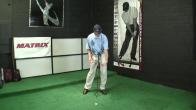My Favorite Videos
Golf Impact Position Down the Line
Sorry, you need to be a member to access to this video.
Become a member here!

As I discussed in the video on Impact Alignments Face On, impact is everything in RST. All the work we do at setup, the takeaway, the backswing, etc. is all to lead to tour caliber impact position to produce powerful, penetrating golf shots. In fact, you can do a lot of things technically wrong in the swing and arrive at a perfect impact position everytime and still play great golf. The key is that all things we work on in the setup, backswing, etc. make achieving this ideal impact position more repeatable with less effort.
- The club should be square to the path at impact
- Tilt in the swing plane affects the path, causing in-to-out or out-to-in shots
- Hip spinners need to drill keeping both hips and shoulders square at impact
- Glutes should be engaged at impact, right arm straightening
- Use an impact bag to drill and a mirror to check impact alignments
At the end of the day, nothing matters more than your impact position. This is the only time you directly influence what the golf ball is going to do, so it better be right. There are a few "pro secrets" about the impact position that I'm going to reveal to you in this video that will make achieving a perfect golf impact position easier and more repeatable.
Where most all golfers go wrong at impact is that they overuse their right arm. The right arm can only push in the downswing and it leads to a flip at impact and the dreaded chicken wing. As soon as you remove the right arm, both of these things instantly go away. Try it for yourself. Grab a golf club and start making practice swings with your left hand only and watch what happens. It's a miracle!
No, not really. But it should help you understand where these issues are coming from in your downswing and golf impact position. The reality is that your impact alignments are controlled primarily by the left side of the body. This is because you need to align yourself with the laws of physics and utilize a pulling motion to keep the clubhead behind the hands and following the hands into impact. If you're not familiar with this concept, check out this golf instruction video on Pushing vs. Pulling in the golf swing.
Once you understand this very important fundamental of the Rotary Golf Swing, you're golf swing will begin to fall into place. Now it won't happen automatically. You'll need to drill this over and over again. Your brain learns new movement patterns through repetition and if you don't continue to repeat these new movements you won't learn them. You can't do a new move a few times and expect that you can take it out to the golf course and do it perfectly. You've never learned anything in your life that way, why would golf be any different?
So, pay close attention to the positions in this golf instruction video and continue to drill them at least 1,000 repetitions and you'll start to gain control of the flight of your golf ball.

























































































































































































































































































































































































































Lauren
Manny (Certified RST Instructor)
Lauren
Manny (Certified RST Instructor)
Juan Eduardo
Craig (Certified RST Instructor)
Juan Eduardo
Craig (Certified RST Instructor)
Roger
Craig (Certified RST Instructor)
Jeff
Dean
Jeff
David
Craig (Certified RST Instructor)
David
Craig (Certified RST Instructor)
David
Craig (Certified RST Instructor)
David
Craig (Certified RST Instructor)
David
Michael
Craig (Certified RST Instructor)
jennifer
Craig (Certified RST Instructor)
jennifer
Antonio
Craig (Certified RST Instructor)
Chad
Craig (Certified RST Instructor)
gordon
Craig (Certified RST Instructor)
gordon
Mark
Craig (Certified RST Instructor)
Antonio
Chris (Certified RST Instructor)
Antonio
Michael
Craig (Certified RST Instructor)
Yew Hwan
Craig (Certified RST Instructor)
Yew Hwan
Andrew
Craig (Certified RST Instructor)
Dan
R.J. (Certified RST Instructor)
John
Craig (Certified RST Instructor)
Greg
Craig (Certified RST Instructor)
Greg
Craig (Certified RST Instructor)
Jason
Chris (Certified RST Instructor)